Tuscany Wine ! Chianti and Chianti Classico are distinct wine appellations in Tuscany, each with its own regulations and characteristics:
Chianti vs. Chianti Classico
Best area in Tuscany for winws, the best Tuscany Wine ! Production area: Chianti covers a larger area across several Tuscan provinces, while Chianti Classico is limited to specific townships in Florence and Siena provinces.
Grape composition: Chianti requires a minimum of 70% Sangiovese, while Chianti Classico demands at least 80% Sangiovese.
Aging requirements: Chianti has a minimum 3-month aging period, whereas Chianti Classico must age for at least 10 months.
White grape allowance: Chianti permits up to 10% white grape varieties, while Chianti Classico only allows red grapes
Italian Wine Classifications
An area of excellence of Tuscany Wine ! DOCG (Denominazione di Origine Controllata e Garantita):
Highest classification for Italian wines
Strictest production rules and quality controls
Wines undergo official tasting procedures
Bottles feature numbered government seals
DOC (Denominazione di Origine Controllata):
Second-highest tier of Italian wine classification
Specific rules for production areas, grape varieties, and winemaking techniques
Less stringent than DOCG but still ensures quality and authenticity.
IGT (Indicazione Geografica Tipica):
More flexible classification introduced in 1992
Allows winemakers to experiment with grape varieties and techniques
Ensures wine is produced within a specific geographical area
Vino da Tavola:
Basic table wine classification
Least restrictive category
No specific regulations on grape varieties or production methods
These classifications form a pyramid, with DOCG at the top, followed by DOC, IGT, and Vino da Tavola at the base. As you move up the pyramid, regulations become stricter and quality standards higher.

